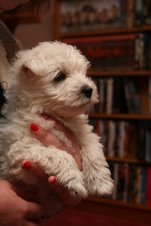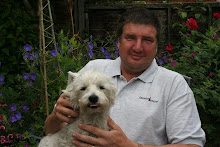 |
| Hubbard chicks at Day 30 stretch out in a sunny patch catching the rays |
Ours were brooded by Betty, of course, and were quickly out free ranging and scratching for worms and grubs, but were fed 'ordinary' mass-produced (i.e. not organic) crumb. By 20 days they were very different. Anne's seemed to be 10 to 20% bigger than ours but still covered only in chick fluff. Ours were smaller but were well feathered up, with wings showing primary,secondary and covert feathers, with well feathered bodies and with tails. It is interesting to think about whether the active outdoor life has them cooler and quickly growing feathers, while the indoor, heat lamp version has them not needing feathers as quickly, so able to put all that protein to body weight. It would be good to know how the third batch are doing and under what regime.
Now, at 30 days, Betty's work seems to be done and she is rarely with them. She has rejoined the 'Lovely Girls' and possibly re-started laying eggs. We have found a couple of new eggs; we have not seen who is laying these yet but BB may well be credited with them. They now find their own way about without her, moving round as a reasonably tight group like the 8-Ball did and take themselves off to 'bed' all piling into one of my new nest boxes rather than perching with their 'Mother'.
 |
| Achillea |
Our orchard, you will recall, is all very new and has only been 'in' a year with planting started in August last year with one or two year old whips and 'feather' trees. We intended only to let it all sit for the first year getting established. We were happy that it blossomed but were not expecting any great fruit crop this year, so we were not disappointed when little fruit set but the Victoria Plum down at the far end of the orchard has quietly been getting on with producing a couple of dozen good sized plums. These are now colouring up well and starting to feel a bit ripe. There will not be enough for jam, but we should get a few desserts out of them and maybe a few for the fruit bowl.
The vegetable garden continues to pump out a lovely selection of vegetables more than enough to keep us and all our guests going and to make a big dent in the freezer space. We will need to invest in a decent size chest freezer this year to cope with the lamb meat. I was out this morning picking a yellow builder bucket full of runner beans and climbing French beans. I have been digging new potatoes of varieties Foremost and Ratte which fortunately escaped the blight. I have not started yet on the double-length row of Sarpo Mira main crop but they have such healthy foliage I cannot believe there will not be a shed load of tubers underground. I am storing them dried a bit but unwashed, in paper sacks in which I buy seed-wheat.
You can see from the pictures that I am still very good for rainbow chard, flat leaved kale and black (Tuscan) kale and calabrese and my small, spring-sown globe artichokes are even producing tiny chokes (which we will probably not actually eat; we will let the plant build up strength and start on that next year). We started into the carrots for the coq-au-vin this week. I have also been making sure to succession-plant to ensure a continuing crop which is not anything I was particularly good at in Kent so that I have more peas and radishes about to start and young beans at the 'first true leaves' stage.
The Jerusalem artichoke plants are huge, towering, 8 foot 'trees' so we are hoping for some good yields there, the French beans keep on coming and the turnips, which we found way too bitter, have kept the rabbits very happy for weeks as a supplementary food and a nice change from grass and herbs. The crunchiness of the turnip roots will also have been good for their teeth.
As crops finish and we move into Autumn proper, I need to be thinking about over-winter crops like onion sets, broad beans and Spring cabbage. It's all go.








2 comments:
I'm envious of the rabbits, feeding them turnips, what a waste! We had our first stew of the autumn today and we could have done with a turnip to take away the sweetness. We planted ours late but they all germinated and have now been thinned, hopefully in a couple of month we will have some, but they wont be going to our rabbits.
We've never done it before, Anne, but the turnips have never been this bitter before. I will try these again next year but the bitterness needs to all leach out into the stew sauce. It was the concentration of it in the turnip lumps which made them very unpleasant. We ended up picking all the turnip bits out like naughty school kids who "don't like it, Mummy!"
Post a Comment